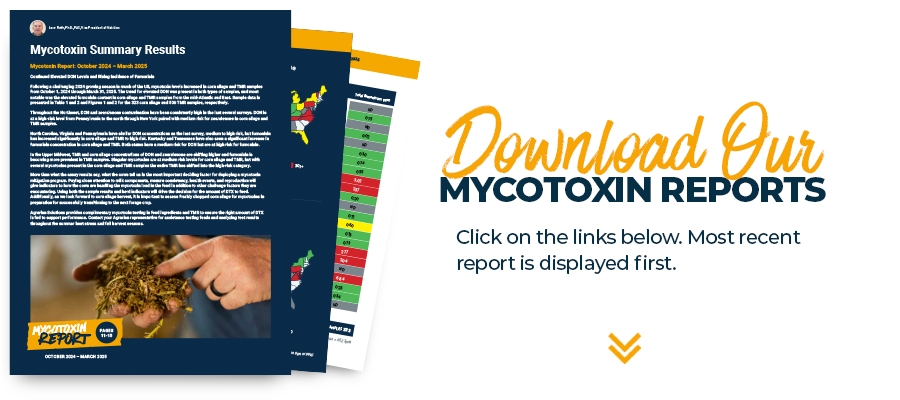Mycotoxins in Your Feed
Mycotoxin Reports. For many years Agrarian Solutions® has been a leader in the distribution of information pertaining to environmental challenges present in livestock feed. We are now very pleased to offer you precise data that can provide even greater insight to guide your decisions and improve the health and performance of your livestock. Activation Laboratories, a global leader in analytical lab services, is providing us with independent and state-of-the-art results. In the pages ahead, you will find extremely helpful information to assist in discerning the best course of action to optimize your animals' performance.

Mycotoxin Report - 2024/2025 (October 24 - March 25)
Mycotoxin Report - 2024 (March - September)
Mycotoxin Report - 2023/2024 (October 23 - February 24)
Mycotoxin Report - 2023 (April - September)
What are mycotoxins?
Mycotoxins are a relatively large, diverse group of naturally occurring, fungal toxins, many of which have been implicated as chemical agents of toxic disease in humans and animals. Mycotoxins produce a wide range of harmful effects in animals. The economic impact of reduced animal productivity, increased incidence of disease due to immunosuppression, damage to vital organs, and interferences with reproductive capacity is many times greater than the impact caused by death due to mycotoxin poisoning.
Mycotoxins are secondary metabolites produced by molds. From the germination of a single spore arises an organism comprised of long, colorless threads (mycelium) which constitutes the ‘body’ of the mold. In the environment, when something essential for growth becomes limited, typically a reduction in available nitrogen or carbon, the biochemistry of the mold switches from primary metabolism that is concerned with the production of cell mass (vegetative growth phase) to secondary metabolism which is associated with the production of spores for continuance of the species (sporulation). Some portions of the secondary metabolic pathways yield products for which no specific function can be attributed, although evidence exists for many possibilities including competitive advantage, precursor pools for spore development, waste products, etc. Amongst these secondary metabolites are some which prove to be harmful to one or more other species. These we call mycotoxins.
The molds synthesizing such toxins are relatively simple organisms with simple needs. There must be a source of carbon and nitrogen, available water with required amounts varying by mold species, and oxygen. They are obligate aerobes. These molds infect plants in various ways such as being vectored in via insects, borne on the wind and entering through plant pollination structures (e.g. the silk in corn), or, for some, becoming directly associated with plant tissues as the plant emerges as a seedling. The rate of growth of molds in pre-harvest plants tends to be relatively slow unless the plant is under some form of stress; then, the infection process and mold level become very high very quickly. In turn, consumption of those nutritive elements of the plant supplying the needed carbon and nitrogen leads to imbalances which stimulate sporulation and secondary metabolism. Thus, mycotoxins can and do form in growing crops. Throughout the agricultural world, there is virtually no plant that is not susceptible to some toxigenic species of mold. Mycotoxins are found in cereals, grasses, oilseeds, fruits, and nuts, to name those commodities most often associated with the feeding of cattle. In animal feeding situations, the mycotoxin picture becomes more complex because most mycotoxins also form readily in post-harvest plant materials. Shell corn, soy meal, orchard residues, etc. are suitable substrates for further attack, typically by a different array of molds than the isolate(s) originally contaminating the growing feedstuffs, and the dynamics of toxin synthesis may also be altered. Ultimately, the TMR placed before the cow is a mixture of several ration ingredients, each with its own current (and past) microfloral profile, and each with some array of mycotoxins. For the domesticated animal it is a matter of how much of which combinations of toxins are present that determines the extent of issues that arise from consumption of the feed.
What do mycotoxins do?
- At the biochemical level...
- Bind to/disrupt basic molecules(e.g., DNA, RNA, proteins)
- At the systems level...
- Disrupt reproduction, nutritional status, digestion & absorption, health functions, normal metabolism
- At the 'whole' animal level...
- Reduce herd/flock performance, herd/flock heal, quality (of meat, milk, eggs), profits
- Increase costs, animal losses
